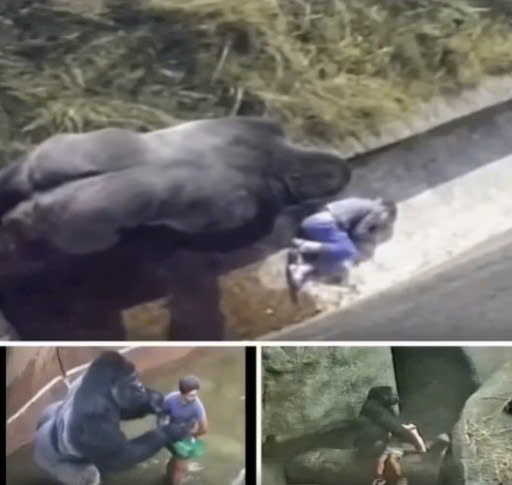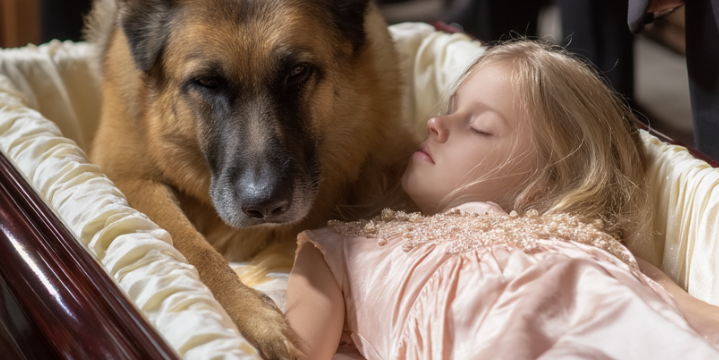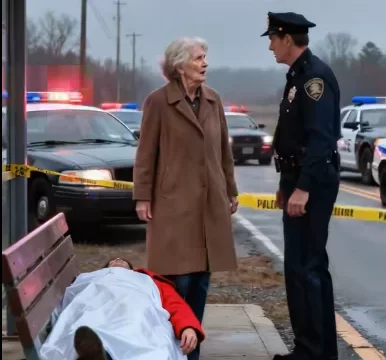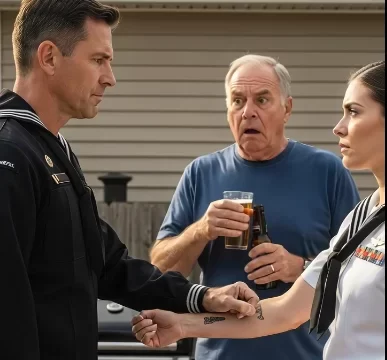It began as an ordinary day at the Cincinnati Zoo—bright skies, laughter echoing through the air, and children pressing their faces to glass panels, wide-eyed with wonder at animals they had only seen in storybooks. Families wandered between exhibits, cameras clicked, and everything felt as it should. But by evening, the zoo would become the center of a global storm—a controversy that would outlive the day itself, forcing humanity to reexamine its relationship with nature, morality, and responsibility.

The moment that changed everything unfolded in a matter of seconds. A three-year-old boy, curious and restless, slipped from his mother’s grasp and climbed over a barrier, tumbling twelve feet into the gorilla enclosure below. Gasps filled the air. The boy landed in the shallow moat that separated visitors from one of the zoo’s most majestic residents—a 17-year-old, 400-pound silverback gorilla named Harambe.
What followed was surreal. Onlookers screamed for help as Harambe approached the child. Dozens of smartphones rose in unison, recording every second of what would soon become one of the most analyzed videos in internet history. Harambe’s massive frame loomed over the tiny boy, his dark eyes seeming to study the situation with a mix of curiosity and confusion. He reached out, touching the child lightly. Then, in a display both terrifying and ambiguous, he dragged the boy through the water. To some, it looked protective—like a parent retrieving a wayward child. To others, it was a scene seconds away from disaster.
From above, zoo officials faced an agonizing decision. The enclosure had no easy access point. Tranquilizers would take too long to act, and any sudden move could agitate the gorilla further. They knew the boy’s life hung by a thread. Within minutes, the zoo’s Dangerous Animal Response Team was mobilized. Then came the shot. One bullet. One instant that ended Harambe’s life—and saved the child’s.
News of the incident spread faster than anyone could have imagined. The video, shaky but undeniable, exploded across social media platforms. Hashtags trended globally within hours. Opinions clashed violently in comment sections, newsrooms, and television panels. Some praised the zoo’s quick decision as tragic but necessary, emphasizing that human life must always come first. Others mourned Harambe as an innocent casualty of human negligence and institutional failure. To many, it wasn’t just about a gorilla—it was about a moral crossroads.
The child’s mother quickly became the focus of online fury. Critics accused her of neglect, while others defended her, pointing out that even the most vigilant parents can lose sight of a toddler in seconds. “People don’t realize how fast it happens,” one mother wrote online. “You turn your head for a moment, and your child is gone.” Meanwhile, animal behaviorists and conservation experts offered their perspectives. Some argued that Harambe had not been attacking but displaying a form of protective curiosity—common in gorillas but dangerous nonetheless. Others suggested he was asserting dominance in a stressful, unnatural environment, reacting to chaos he couldn’t understand.
“There were no villains in that enclosure,” said Dr. Elaine Matthews, a primatologist who studied gorilla behavior for two decades. “There was a frightened child, a stressed animal, and a team forced to make an impossible choice in real time. It was not cruelty—it was tragedy.”
The tragedy, however, quickly became something more. Harambe’s death sparked a global conversation about humanity’s relationship with wild animals in captivity. Should creatures with such intelligence and emotional depth be confined for public display? Are zoos still ethical in a modern world where conservation can happen in the wild? The questions spread far beyond Cincinnati, challenging both science and conscience.
Then, as the internet often does, it transformed grief into something strange. Within weeks, Harambe became a global meme. His image flooded social media—half reverent, half ironic. “Justice for Harambe” trended for months, while countless posts turned him into a cultural phenomenon, part tragedy, part satire. For some, the humor was a coping mechanism—a way to process collective guilt. For others, it felt disrespectful, trivializing the death of a sentient being who had, in his final moments, seemed almost gentle.
Yet beneath the noise, Harambe’s legacy began to take shape in quieter, more meaningful ways. Zoos around the world reevaluated their safety protocols, reinforcing barriers and redesigning enclosures to prevent similar incidents. Educational programs expanded to teach visitors about gorilla behavior and the delicate balance between conservation and captivity. Animal-rights organizations gained renewed momentum, pushing for sanctuaries over traditional zoos. And families everywhere found themselves talking—sometimes painfully—about accountability, empathy, and the value of all life, human or animal.
Years later, the debate hasn’t faded. It resurfaces whenever a zoo incident occurs, whenever footage of a close animal encounter goes viral, whenever society is reminded that the boundary between “us” and “them” is far thinner than we like to believe. Harambe became more than a gorilla; he became a mirror—reflecting both the best and worst of humanity’s relationship with the natural world.
For the boy, now grown, the event remains a distant blur—something he cannot fully remember but that shaped his life in ways he’ll never escape. For his parents, it’s a reminder of gratitude intertwined with guilt: a son saved, but at a great cost. For the zoo staff, it’s a scar—a day that tested their duty to protect both visitors and animals, and forced them to live with a decision that was right, yet heartbreaking.
Perhaps what makes the Harambe story endure is that it resists simplicity. There are no clear heroes or villains. There is only the tragic intersection of instinct, innocence, and responsibility. It challenges us to acknowledge that even our best intentions can lead to devastating consequences. It asks whether our desire to be close to nature—to touch, to see, to possess—comes with moral obligations we too often ignore.
In the years since, Harambe’s name has been written into cultural memory. He exists now as symbol and cautionary tale, a reminder of the fragility of coexistence. His story lives in every zoo’s reinforced glass barrier, every parental warning to “stay close,” every debate over animal rights and human safety.
What began as an ordinary trip to the zoo became one of the most defining ethical conversations of the 21st century. The world’s grief, outrage, and introspection converged on one enclosure in Cincinnati, where a boy’s innocence met the raw unpredictability of the wild.
Harambe’s legacy isn’t found in memes or headlines—it’s found in the difficult, necessary questions he left behind. How do we respect life that doesn’t look like ours? How do we make choices when every option feels like loss? And how do we learn from a moment that was, at once, both tragic and profoundly human?
Because in the end, the story of Harambe isn’t just about a gorilla and a boy. It’s about all of us—our compassion, our contradictions, and our struggle to do what’s right when there are no easy answers.





